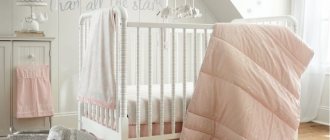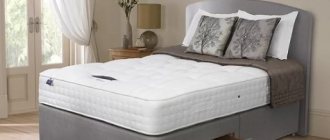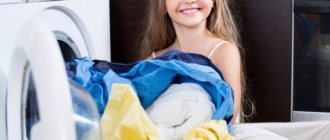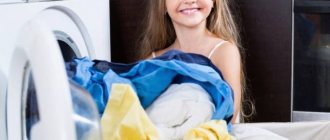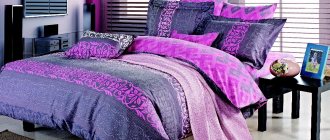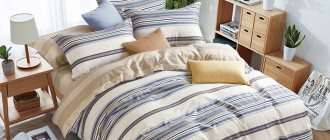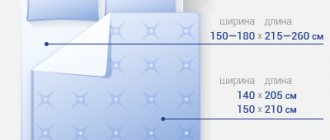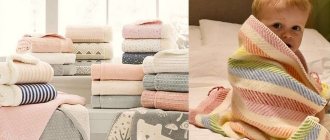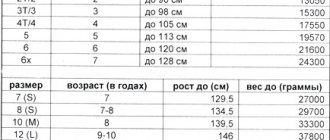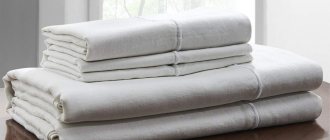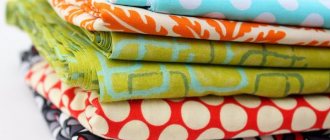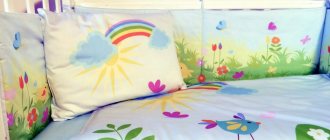Children's sleep is the time during which children can relax, recharge their batteries and gain strength for new games and interesting events. Therefore, a great responsibility falls on the shoulders of parents for organizing comfortable children's sleep. Here it is important not only to choose the right pajamas, but also the entire bedding set. What size bedding is suitable for a child's crib? This question often worries parents when choosing bedding sets. All sizes of necessary attributes for sleep are selected taking into account the age of the child and the dimensions of the bed.
Standard sizes of children's bed linen
Baby bedding sets for newborns or teenagers come in different sizes. When choosing a bedding set, you need to know the dimensions of the bed, blanket and pillows. As a rule, the child sleeps on a single bed. For them it is necessary to purchase bed linen, the standard sizes of which are:
- duvet cover – 115x147 cm;
- sheet – width – 120x150 cm;
- pillowcase – width – 40x60 cm.
When purchasing children's sleeping sets, you must find out what fabric was used in their manufacture, its naturalness and the quality of the dyes.
Children's bedding can be made from:
- cotton - its characteristics include softness and environmental friendliness;
- satin - is a dense silk fabric, the front side of which is smooth and shiny;
- calico - light cotton material;
- flax - has a smooth surface and matte shine;
- satin lux - durable and shiny material;
- poplin - cotton, silk fabric. The main differences between poplin and satin can be found here;
- polyester is a synthetic, soft fabric.
Essential supplies for newborns
- Bed: can be either rectangular, standard sizes 120x60, or oval and in the form of a cradle. It all depends on your preferences. But, if an ordinary crib of standard dimensions is 120x60, it can last you up to a three-year-old baby. A bed in the form of a cradle will have to be changed by the age of 4-6 months, since it is intended only for newborn babies and when your baby starts trying to sit up, this crib will be unsafe for him.
- Mattress: we also select it according to the size of the crib. In this case, for a standard-sized crib, a mattress measuring 120x60 is suitable. The filler can be completely different, coconut fiber, polyurethane foam, spring block. The main key here is rigidity and environmental friendliness. A child is born with an incompletely formed spine, therefore, the correct choice of a children's mattress determines how correctly it will be formed.
In the crib: duvet cover, pillow, sheet
A baby's crib is his favorite place. After his birth, he spends almost all his time in it. For newborn babies, the most important thing is healthy and comfortable sleep, which is necessary for normal growth and development. For this reason, you need to be especially careful when choosing bed linen, mattresses for newborns and blankets. The standard sizes of bedding needed for sleeping are as follows:
- sheet – 110x150 cm;
- duvet cover – 112x147 cm;
- pillowcase – 40x60 cm.
The cost of such a purchase may vary. There are two options here: buy underwear in a store and sew it yourself. The last option is advisable to use when the baby’s crib has non-standard dimensions. The finished set will perfectly match the required dimensions.
When choosing a bedding set for small children, it is also necessary to take into account the naturalness of the fabric, seams and compliance with sanitary and hygienic standards.
The appearance of a little man is a great joy for any family. Every parent tries to purchase only the best and highest quality for their child.
Children's bedding sets and their types
Today you can find the following varieties on sale:
- Single. Can be used for a classic single bed or for a crib. Designated as “single” or “1-bed”.
- One and a half. Typically used for teenagers. The standard designations for such products are “1.5-bed” or “extra-long single”.
- Babybed. Sets with this designation are used for cribs for newborns and small children.
In addition to size, you also need to consider the quality of the fabric. It must be safe for the child. Psychologists also say that you need to take color into account – it can affect the quality of sleep.
Standards in baby kits
A ready-made bedding set (FBS) for babies includes the following accessories:
- Blanket – 110x140 cm. In hot weather, a thin blanket and a flannel blanket are enough for newborns, in winter – two thin ones and a down one. All of them are small and compact in size.
- Duvet cover – 112x146 cm.
- The side for protection is 360 cm x 36 cm. In winter, it is advisable to use a soft one, since in summer it disrupts air circulation.
- Pillow (thin as standard).
- Pillowcase – 60x40 cm.
- Canopy with fastening.
- Side pockets and mattress cover.
- Bed sheet – 127x146 cm (can be made with elastic).
Convenience
If the child is very active, then it is better to choose a pillowcase with an elastic band, so it will not bunch up. There will be no folds on it, which can also cause skin irritation. Pay attention to the recommendations for washing and ironing. This is also quite important, because bedding for very small children needs to be washed and ironed often.
For teenagers
If you need to choose bedding for a teenager, then color and design are important. Stores offer a wide selection of bedding: with movie characters, cartoons, comics and various patterns.
For teenagers, bright appliques would be an excellent option, both for boys and girls.
The standard sizes of the teenage set are as follows:
- duvet cover – 145x215 cm;
- sheet – 150-220 cm;
- pillowcase – 50x70 cm.
Bed sheet parameters
The sheet more often than other bedding becomes unusable. The product is designed to protect the mattress and children's skin from contact with the hard cover.
Size chart for crib sheets
| Name | Size(cm) |
| Standard | 120x150 |
| Nursery | 110x150 |
| For newborns | 127x146 |
| For teenagers | 150x220 |
The most comfortable model is considered to be sheets with elastic around the edges. This model tightly covers the mattress and does not allow the product to wrinkle or slide off. Most often, they are part of nursery sets.
For kindergarten, nursery group
In kindergartens and nursery groups, bed linen should be made only from natural fabrics and meet all the requirements of the sanitary station. Most often, satin, linen, chintz or calico are used for sewing linen.
Bedding sets for kindergarten include: pillowcase, sheet and duvet cover. The color can be any.
The kit dimensions are as follows:
- sheet – 100 x145 cm;
- duvet cover – 110x145 cm;
- pillowcase – 40x60 cm.
We also recommend that you learn about which filling to choose for pregnancy pillows.
Pillow
A variety of shapes and fillings for pillows provide a choice for purchasing a wide variety of types. Parents can buy a pillow for their children, both with natural and synthetic fillings, and even choose a special orthopedic pillow that will serve as a means to preserve the child’s health.
Types of fillers:
- down and feather;
- bamboo fiber;
- padding polyester;
- holofiber;
- eco filler;
- reed fibers.
Pillow sizes can be from 30 cm or more. Their width and length will depend on the choice. Children's pillows are smaller in size than adult models and have less thickness. The use of a pillow should begin as soon as the child needs it and after consultation with a pediatrician or orthopedist.
Find out about the benefits of an anatomical pillow for a newborn in this
Thermal bag for baby food - keep warm!
Is a sterilizer really necessary for children's dishes? https://klubmama.ru/sovety-roditelyam/detskie-veshhi/sterilizator-dlya-detskoj-posudy-prixot-ili-neobxodimost.html How to choose it?
Double set
Not so often, but many people use double children's sets. Due to their low demand, manufacturers practically do not produce them. The set includes a duvet cover, a sheet and two pillowcases. The double bedding set has the following dimensions:
- sheet – 180 x260 cm;
- duvet cover – 160 x220 cm;
- pillowcase – 50 x 70 cm.
In addition to the usual standards, there are also “euro” standards. They are used by foreign manufacturers during tailoring. They are slightly different from ours:
- duvet cover for Euro size blanket – 200 x 220 cm;
- sheet – 215 x240 cm;
- pillowcase – 50 x 70 cm.
You may encounter a situation where a child’s bed, blanket and pillow do not meet the required dimensions. In this case, choosing a suitable kit will be difficult.
You can use this advice: measure the required dimensions and add 5 cm to them. This way you will get the optimal size.
Single bed linen table for baby
Table 1 - Dimensions of children's bedding - single version:
| Manufacturer | Mattress, cm | Sheet, cm | Fitted sheet, cm | Duvet cover, cm | Pillowcase, cm |
| Russia | 120x150 | 115x147 | 40x60 | ||
| Europe | 56x118 | 120x170 | 60x120 | 100x120 | 40x60 |
| America | 71x132 | 107x183 | 71x132 | 101x121 | 40x60 |
The quality of your child's sleep will determine his mood in the morning. Therefore, take care of quality bedding. It should be environmentally friendly, pleasant and fit the size of the baby’s crib. Also read which blanket is best to choose for sleeping.
Recommended materials
Pay special attention to the type of fibers used to make the fabric. Only natural materials such as cotton, linen, and silk meet the high requirements for children's underwear. Also included in this category is bamboo, a fiber that can become a worthy replacement for cotton.
To sew children's sleeping sets, five types of fabric are most often used, which are based on natural fibers.
- Chintz. Lightweight fabric made from cotton. This material is most often used for summer bedding sets. But it will be too heavy for a small child.
- Satin. Smooth, beautiful fabric. Usually made from silk fiber. But sometimes, in order to reduce the cost, cotton is used. Thanks to a special satin weave, this bed has a shiny surface and is pleasant to the body.
- Calico. Affordable, dense fabric made from cotton. This is a traditional material for bedding.
- Ranfors. This fabric is an improved version of calico, invented in Turkey. The material has increased density and is smooth.
- Percale. One of the strongest fabrics, yet pleasant to the touch. According to reviews, such linen will withstand many washes.
Sometimes bed linen contains not only a natural component, but also a synthetic one, called polyester. This is not something to be afraid of. A small amount of synthetic fiber allows you to reduce the cost of the product, provides better ironing, and prevents creasing.
Fillers and insulation for pillows and blankets
A down blanket is warm and light, but it is not recommended for allergy sufferers.
The filling for a baby blanket should be light and comfortable. It is best if the blanket can simply be washed in a regular washing machine without spoiling the performance of the product. That’s why, when purchasing bedding sets for children, it is better to focus on the following options:
- Wool is a traditional natural filler that has been used by mankind as insulation since ancient times. This is a humane material because animals are shorn or combed to obtain raw materials. Wool is light, elastic, warms well, prevents overheating, and quickly absorbs moisture. However, the material requires special care - it is best to dry clean the products. The most suitable varieties of wool for blankets come from sheep and camels.
- Down is a soft and delicate material. This is a warm, delicate, hygienic filler. It requires careful handling, costs a lot and needs proper care. When using a blanket made of natural down, you must ensure that the product does not cause allergies.
- Silicone - this synthetic filler is pleasantly elastic and light. You should use silicone blankets with caution - the filler accumulates static electricity and, as a result, attracts dust.
- Synthetic winterizer is a cheap, affordable, proven material that has been tested for years, but is not particularly durable. You can buy padding polyester blankets for the youngest children, because kids grow quickly and the item may not have time to wear out.
- Holofiber is considered one of the best synthetic fillers for blankets and pillows. Holofiber consists of a mass of spiral-shaped polyester fibers. When pressed, the material gives way and immediately straightens when the pressure disappears. The material does not crumple, it is reliable and safe.
The pillow should be moderately soft and elastic, the absence of foreign odors, as well as ease of care, is important. The best fillings for children's pillows are:
- Bamboo is an eco-friendly plant material that is good for health. Bamboo fibers allow air to pass through well, they are elastic, and the products made from them are durable.
- Camel wool is a soft, lightweight natural material, considered lighter than sheep wool and has a positive effect on health.
- Sheep wool is more affordable financially than camel wool. The material is easy to care for and environmentally friendly.
- Comforel is a synthetic filler made of polyester fibers coated with silicone. Form-stable filler, safe, does not cause allergies.
The materials mentioned above are also used as filler for pillows: holofiber, natural down, padding polyester. Some parents use aromatic sachets with bergamot, lavender, rose, chamomile and hops as additional material for a healthy and restful sleep for the baby.
How to choose the height of a pillow for a child
The first thing you need to measure is the length and width of the bed. Add 10-15 cm to this size - this will be the size of the sheet.
Now measure the size of the blanket 3-5 cm for the size of the duvet cover.
https://www.youtube.com/watch?v=ytaboutru
Pillowcases should also be selected according to the size of the pillow, but if the bed linen set with pillowcases is 70*70 cm, and your pillows are 50*70, you can easily tuck the pillows neatly into such pillowcases.
A baby spends significantly more time in the crib than a schoolchild or teenager. Children also differ in height, some are just toddlers at five years old, while others have grown tall and the standard set for a preschooler is not suitable for them; they need to take larger accessories. The only thing that must be strictly observed when choosing textile accessories for children of any age is their high quality.
The dimensions of bed linen should be selected based on the height and weight of the child
We take a tape measure in our hands and measure the following parameters: the length and width of the mattress, pillows and blanket.
If you have a wide non-standard bed with two one-and-a-half mattresses, then you can consider purchasing two identical one-and-a-half sets.
Bed linen differs not only in size, but also in the number of components. By type they are divided into:
- Single
- One and a half
- Double
- Family
- Children's
- For newborns
sleeping on pillows is contraindicated. Aged
If necessary, you can place a thin pillow up to 3 cm high under your head.
The permissible thickness of the bedding is 4-6 centimeters.
If you choose an anatomical pillow for your child, you need to focus on the height of the half-roll, which will be under the neck, and not on the height of the middle part. Higher pillows can be offered to children who are used to sleeping on their side
It is important that the neck remains parallel to the surface of the bed. If it is raised, you need a lower pillow; if it is lowered, you need a higher one.
To sleep on your back, you need to buy a pillow even lower so that your chin does not bend towards your chest and the blood supply to the brain is not disrupted.
A baby pillow should be natural, hypoallergenic, hygienic, comfortable, able to relax the neck and keep the spine in a natural position.
Anatomically shaped models made of natural latex or materials with memory effect are most suitable for these criteria. They are almost ideal from an orthopedic point of view, guarantee the prevention of many spinal problems and provide more ergonomic support. In addition, latex and memory foam materials are hypoallergenic, safe, hygienic, breathable and durable. And the special shape of the ergonomic wave was created specifically to ensure that the neck received reliable support while remaining as relaxed as possible.
https://www.youtube.com/watch?v=ytadvertiseru
If your baby cannot get used to the unusual shape of an anatomical pillow, consider silk pillows for children among the classic ones. Silk is not only natural, but also has hypoallergenic and antibacterial properties, making it an ideal choice for babies and children prone to allergies.
Also, in hot weather, silk creates a slight cooling effect, which eliminates heavy sweating at night. By the way, silk pillows are the thinnest. They can be bought for the youngest children under 7 years old.
Pillows made from buckwheat husks have also proven themselves to be excellent, as they subtly adapt to the contours of the child’s body. They allow air to pass through perfectly and provide a pleasant massage effect, they are natural and hygienic. The only obstacle to their use may be the rustling sound, which the baby will have to get used to.
The optimal shape of a classic children's pillow is a rectangle. In this case, the head and neck receive the necessary support, and the shoulders remain on the mattress. Buying a square pillow for a child risks the fact that he will lie on it with his shoulders, and this is contraindicated for proper rest and complete relaxation.
Orthopedic pillows for children have the shape of an ergonomic wave with one or two half-rollers at the edges and a recess in the center. This solution is thought out and recommended by the best doctors. The head is fixed, receives the necessary support, and the neck relaxes as much as possible.
When choosing the size and shape of a pillow, you can rely on your preferences and the tastes of your child. You just need to remember to take into account the width of the crib so that the purchase fits in it, does not hang down, but also so that the child does not slide off the pillow, turning over from side to side.
Choose a pillow for your child
Orthopedic
Orthopedic pillows are very popular now. They say about such models that they have a special shape that ensures that the head is maintained in the desired position. Orthopedic pillows must have a special recess and sides around it.
According to the creators, their products provide:
- decreased muscle tone in the neck;
- normalization of cervical circulation;
- correct formation of the cervical spine.
For the manufacture of such products, synthetic materials are used that have increased elasticity and hold their shape well. These are latex, polyurethane foam, polystyrene.
There are several types of orthopedic pillows.
Pillow – butterfly
- Promotes the correct formation of the skull bones and the curvature of the cervical spine;
- It is recommended for torticollis (read the article on the topic Torticollis in a newborn >>>), damage to the cervical vertebrae during childbirth, as well as for rickets.
Important! However, for torticollis, I would not recommend rushing to use a special pillow. After all, this is not a disease, but a muscle spasm that occurs in many newborns
An experienced osteopath eliminates this phenomenon in 1-2 sessions. The pillow cannot boast of such an effect.
Cushion – positioner
- This model is also called “cocoon”. It ensures fixation of the body in the desired position;
- A pillow-positioner is used if a newborn has muscular dystonia;
- It can also be useful if the child always turns on one side and this causes deformation of the skull;
- This pillow is used from the moment of birth and exclusively for medical reasons.
Read more about the features of this type of pillow in the article Sleep positioner for a newborn>>>
Inclined pillow
- Typically this pillow is the same width as the crib;
- For this model, the upper surface is located at an angle (no more than 30◦);
- The inclined pillow provides an elevated position for the newborn's upper body. This will protect the baby during regurgitation;
- This model can be used from the first days after birth.
Important to remember! Before using an orthopedic pillow for newborns, you should consult your pediatrician.
Color spectrum
Another important criterion that parents don’t think much about is the shade of the laundry. Carefully measuring the child’s height and the dimensions of the mattress, they manage to focus on safety and comfort, completely losing sight of the colors. Psychologists say that with the help of the right color scheme, you can grow a talented, self-confident person, and sometimes even cure mental illness. The effect of color on a child's body is indicated in the table below.
Table - Primary colors and their effect on the child’s body
| Bed color | Impact on the psyche |
| Green | - Helps relax; - promotes calmness |
| Red | - Causes aggression; - capable of oppressing |
| Yellow | — Improves mood; - causes joy; – provokes anxiety (if abused) |
| Blue | — Normalizes sleep; - promotes relaxation; - provides calming to the nervous system |
| Blue | — Eliminates tension (only as small accents); — helps to fall asleep (if the shade is not dominant); - depresses the nervous system (if blue is the main color) |
| White, beige | — Calms the nervous system; - ensures restful sleep; - leads to melancholy if not diluted with bright colors |
| Grey | — Promotes self-confidence (only small accents) |
| Brown | - Causes boredom; - can provoke apathy |
| Black | — Causes destruction of the child’s psyche (in large quantities); - neutral if used as outlines of a picture or small print |
